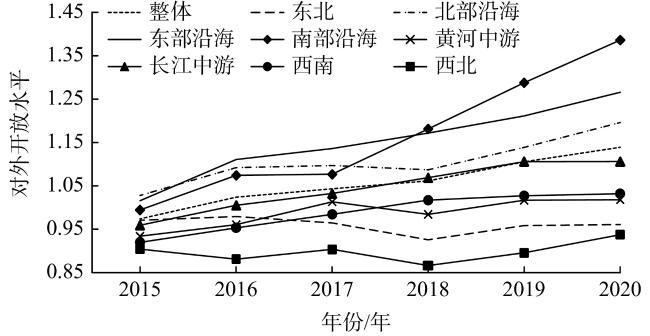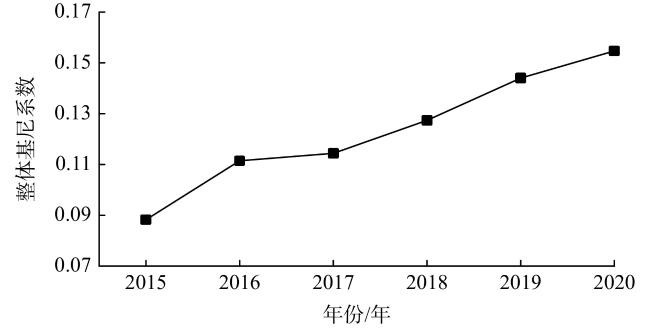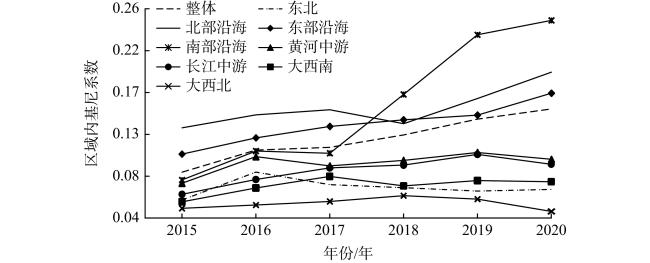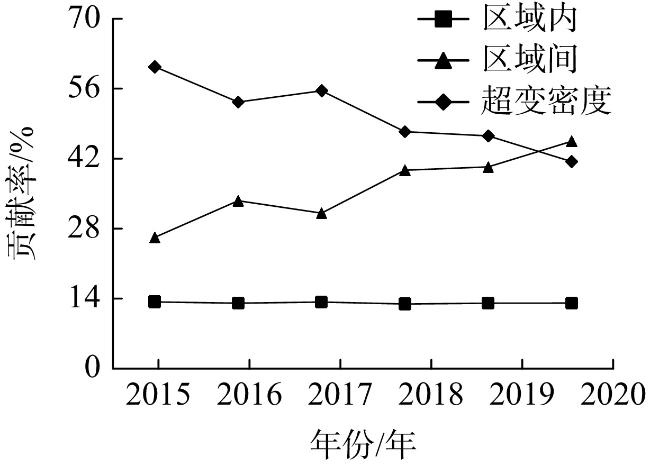1 研究方法与研究样本
2 国家高新区开放创新水平评价指标体系构建
2.1 国家高新区开放创新水平评价指标体系构建
表1 国家高新区开放创新水平的评价指标体系 |
| 目标层 | 一级指标 | 二级指标 |
| 国家高新区 开放创新水平 | 各类机构开放 创新度 | 园区当年外资企业数 |
| 外资研发机构数 | ||
| 企业设立的境外分支机构数(研发、生产和营销机构) | ||
| 企业委托境外单位(企业、高校以及科研院所)开展的科技活动经费支出 | ||
| 多元要素开放 创新度 | 海外留学归国人员和外籍常驻员工占从业人员的比例 | |
| 拥有的境外注册商标数 | ||
| 当年欧美日专利授权数 | ||
| 企业累计主导或参与制定的产业国际标准数 | ||
| 当年实际利用外资金额 | ||
| 当年引进境外技术和消化吸收费用支出 | ||
| 当年内资控股企业海外直接投资额 | ||
| 经济贸易开放 创新度 | 园区企业出口总额 | |
| 高新技术产品出口占出口总额的比例 | ||
| 技术服务出口额占出口总额的比例 |
2.2 国家高新区开放创新水平评价结果分析
2.3 3类园区开放创新水平与增长率分析
3 Dagum基尼系数及其分解结果
3.1 8大地区国家高新区开放创新水平的整体区域差距
3.2 国家高新区开放创新水平的区域内差距
3.3 国家高新区开放创新水平的区域间差距
表2 区域间差距 |
| 区域 | 年份/年 | 均值 | |||||
| 2015 | 2016 | 2017 | 2018 | 2019 | 2020 | ||
| 东北与北部沿海 | 0.10528 | 0.12651 | 0.12462 | 0.12033 | 0.13022 | 0.14953 | 0.12608 |
| 东北与东部沿海 | 0.09037 | 0.11556 | 0.12120 | 0.14256 | 0.13972 | 0.15893 | 0.12806 |
| 东北与南部沿海 | 0.07392 | 0.10649 | 0.10347 | 0.15313 | 0.18576 | 0.20869 | 0.13857 |
| 东北与黄河中游 | 0.07331 | 0.09872 | 0.08755 | 0.09043 | 0.09289 | 0.09058 | 0.08891 |
| 东北与长江中游 | 0.06424 | 0.08689 | 0.08814 | 0.10449 | 0.10325 | 0.10058 | 0.09127 |
| 东北与大西南 | 0.06535 | 0.08283 | 0.08271 | 0.08786 | 0.08066 | 0.08031 | 0.07995 |
| 东北与大西北 | 0.06459 | 0.08317 | 0.07350 | 0.07513 | 0.06954 | 0.06221 | 0.07135 |
| 北部沿海与东部沿海 | 0.12526 | 0.14059 | 0.15037 | 0.14745 | 0.16418 | 0.19140 | 0.15321 |
| 北部沿海与南部沿海 | 0.11145 | 0.13365 | 0.13594 | 0.16082 | 0.20921 | 0.23420 | 0.16421 |
| 北部沿海与黄河中游 | 0.11299 | 0.13726 | 0.13008 | 0.12577 | 0.14293 | 0.15778 | 0.13447 |
| 北部沿海与长江中游 | 0.10679 | 0.12327 | 0.12956 | 0.12152 | 0.14088 | 0.15170 | 0.12895 |
| 北部沿海与大西南 | 0.10794 | 0.12603 | 0.13179 | 0.11399 | 0.12961 | 0.14598 | 0.12589 |
| 北部沿海与大西北 | 0.10733 | 0.13336 | 0.12917 | 0.13270 | 0.13949 | 0.14426 | 0.13105 |
| 东部沿海与南部沿海 | 0.09648 | 0.12047 | 0.12551 | 0.15975 | 0.19845 | 0.21626 | 0.15282 |
| 东部沿海与黄河中游 | 0.09728 | 0.12834 | 0.12381 | 0.14039 | 0.14517 | 0.15977 | 0.13246 |
| 东部沿海与长江中游 | 0.09014 | 0.10857 | 0.12083 | 0.12666 | 0.13309 | 0.14323 | 0.12042 |
| 东部沿海与大西南 | 0.08983 | 0.11286 | 0.12541 | 0.12356 | 0.13197 | 0.14814 | 0.12196 |
| 东部沿海与大西北 | 0.08994 | 0.12598 | 0.12899 | 0.15930 | 0.15727 | 0.15824 | 0.13662 |
| 南部沿海与黄河中游 | 0.08308 | 0.11891 | 0.10809 | 0.15293 | 0.19272 | 0.20777 | 0.14392 |
| 南部沿海与长江中游 | 0.07513 | 0.10175 | 0.10568 | 0.14192 | 0.18395 | 0.19414 | 0.13376 |
| 南部沿海与大西南 | 0.07639 | 0.10518 | 0.10979 | 0.13978 | 0.18306 | 0.19726 | 0.13524 |
| 南部沿海与大西北 | 0.07639 | 0.11603 | 0.11039 | 0.16879 | 0.19952 | 0.20749 | 0.14643 |
| 黄河中游与长江中游 | 0.07292 | 0.09742 | 0.09507 | 0.10678 | 0.11498 | 0.10842 | 0.09927 |
| 黄河中游与大西南 | 0.06835 | 0.09102 | 0.09474 | 0.09323 | 0.09657 | 0.09247 | 0.08940 |
| 黄河中游与大西北 | 0.06658 | 0.08775 | 0.08997 | 0.09583 | 0.09654 | 0.08123 | 0.08632 |
| 长江中游与大西南 | 0.06400 | 0.07932 | 0.09285 | 0.09154 | 0.10139 | 0.09486 | 0.08733 |
| 长江中游与大西北 | 0.06403 | 0.08516 | 0.09008 | 0.11815 | 0.11693 | 0.09591 | 0.09505 |
| 大西北与大西南 | 0.05571 | 0.07111 | 0.07733 | 0.09661 | 0.08628 | 0.06941 | 0.07607 |
3.4 国家高新区开放创新水平区域差距来源的识别
4 国家高新区开放创新水平空间转移特征
4.1 传统Markov链估计结果分析
表3 全期和分时期的国家高新区开放创新水平的传统Markov链转移概率矩阵 |
| a−1/a | 低 | 中低 | 中高 | 高 |
| 低 | 0.18919 | 0.27027 | 0.27027 | 0.27027 |
| 中低 | 0.02703 | 0.32432 | 0.24324 | 0.40541 |
| 中高 | 0.02703 | 0.16216 | 0.37838 | 0.43243 |
| 高 | 0.08333 | 0.02778 | 0 | 0.88889 |
4.2 空间Markov链估计结果
表4 全样本周期国家高新区开放创新能力的空间Markov链转移概率矩阵 |
| 空间滞后 | a/a−1 | 低 | 中低 | 中高 | 高 |
| 低 | 低 | 0.09091 | 0.36364 | 0.27273 | 0.27273 |
| 中低 | 0 | 0.40000 | 0.30000 | 0.30000 | |
| 中高 | 0 | 0.11111 | 0.44444 | 0.44444 | |
| 高 | 0.14286 | 0.14286 | 0 | 0.71429 | |
| 中低 | 低 | 0.33333 | 0.22222 | 0.33333 | 0.11111 |
| 中低 | 0 | 0.16667 | 0.16667 | 0.66667 | |
| 中高 | 0.08333 | 0.16667 | 0.58333 | 0.16667 | |
| 高 | 0.10000 | 0 | 0 | 0.90000 | |
| 中高 | 低 | 0.28571 | 0.28571 | 0.14286 | 0.28571 |
| 中低 | 0.10000 | 0.50000 | 0.30000 | 0.10000 | |
| 中高 | 0 | 0.18182 | 0.18182 | 0.63636 | |
| 高 | 0.11111 | 0 | 0 | 0.88889 | |
| 高 | 低 | 0.10000 | 0.20000 | 0.30000 | 0.40000 |
| 中低 | 0 | 0.18182 | 0.18182 | 0.63636 | |
| 中高 | 0 | 0.20000 | 0.20000 | 0.60000 | |
| 高 | 0 | 0 | 0 | 1.00000 |














